The next big thing in surfing is artificial waves you can ride anywhere, any time
Bruce McFarland’s San Diego office is just a skateboard ride from some of California’s prime surf spots. And right now, McFarland is gazing at the perfect wave—a glassy, barreling wall of water. But it’s breaking inside his building, and McFarland, an engineer and surfer, is controlling the wave with an iPad.
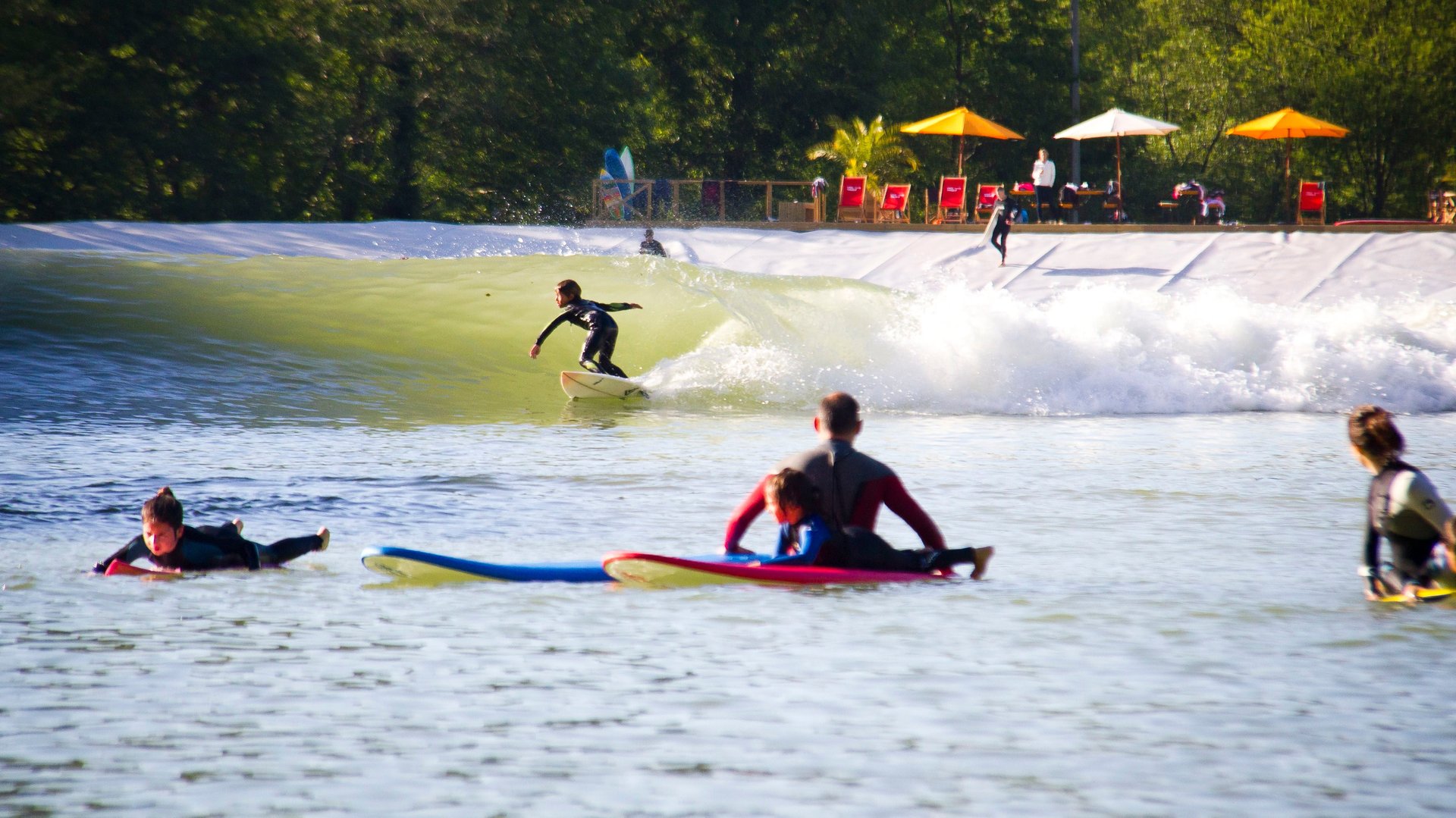

Bruce McFarland’s San Diego office is just a skateboard ride from some of California’s prime surf spots. And right now, McFarland is gazing at the perfect wave—a glassy, barreling wall of water. But it’s breaking inside his building, and McFarland, an engineer and surfer, is controlling the wave with an iPad.
Sure, the wave is only three inches tall and is contained in a pint-sized pool built by McFarland’s company, American Wave Machines. But two surf parks deploying the company’s PerfectSwell technology are set to open in Russia and New Jersey, generating four- to six-foot (1.2 to 1.8 meter) waves at the push of a button. “We want to create waves so that anyone, anywhere can surf,” says McFarland.
Bringing surfing to the landlocked masses could be the biggest change to hit the sport since Hawaii’s Duke Kahanamoku taught Californians how to ride the waves a century ago. American Wave Machines is just one of half a dozen companies developing artificial wave technology, including a Los Angeles startup founded by 11-time surfing world champion Kelly Slater.
With a mix of hope and hype, the $7 billion surf industry is embracing wave parks as way to grow a flat-lining business. Kids in Kansas and Qatar could become real surfers, not just boardshorts-wearing wannabes. Pro surfing executives, meanwhile, are pushing surf parks as predictable, television-friendly venues to stage competitions as they lobby to make surfing an Olympic sport. “Surf parks will create an entire new generation of aspirational surfers,” says Jess Ponting, director of the Center for Surf Research at San Diego State University. “These new surfers will not just buy for fashion but for equipment as well, and not just in the US but in Russia, China and Europe.”
Surfing has always been as much a way of life as a sport, the exclusive domain of a coastal wave tribe with its own rites and rituals. (Disclosure: I’m one of them.) Now with dozens of surf parks under development worldwide, surfing is about to get Disneyfied—buy a ticket, stand in line, and go for a ride.
Cracking the wave code
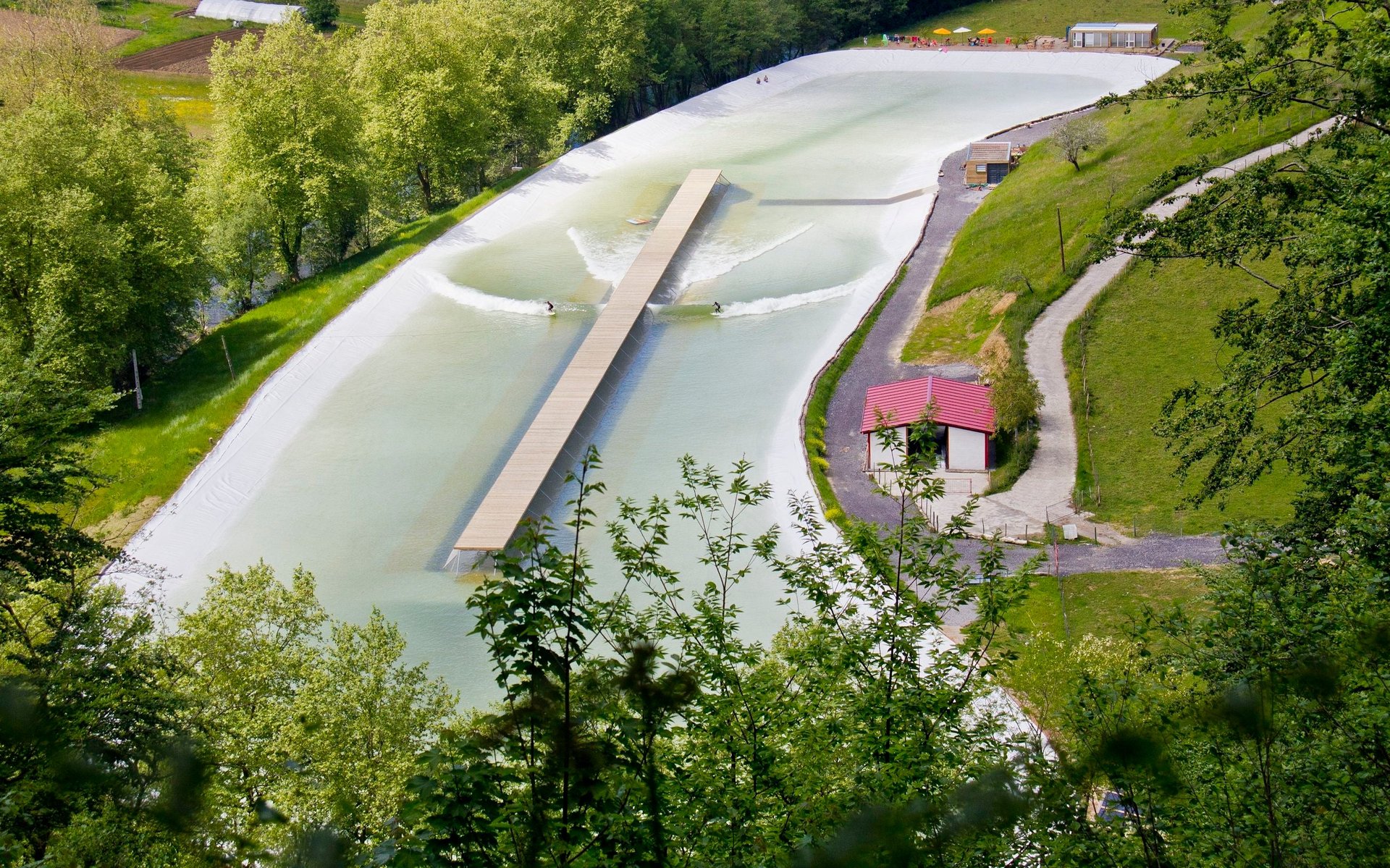
In the ocean, no two waves are alike. Each one is formed by constantly changing conditions—winds, tides, swell, sandbars. Even if you’re lucky enough to live on the coast near surf breaks, there’s no guarantee there will be rideable waves on any given hour or day. That unpredictability can make honing one’s surfing skills a time-consuming process, demanding a commitment bordering on obsession.
That’s also problematic for pro surfing. Small surf and long lulls between sets of waves do not make for exciting television, so it’s hard to attract the viewers that advertisers and sponsors covet. Contests last for days, stopping and starting as ocean conditions dictate. They cannot be scheduled into two-hour, TV-friendly time slots. The window for holding the annual Mavericks big wave competition in northern California, for instance, runs from November until April and the contest is called on 48 hours notice when huge waves—30-foot plus—appear. “There’s no way a surf contest will ever be on ESPN Live,” says Matt Reilly, director of marketing at Surf Park Central, a website that covers the nascent artificial wave industry.
A surf park, on the other hand, can ideally churn out one identical wave after another. Replicating Mother Nature is not so easy, though. Most wave parks built over the past 20 years offer a so-called standing wave: A sheet of water is pumped into a pool and over a barrier to create a continuous breaking wave that stays in place. Riders can balance on a surfboard and maneuver to some degree. But the wave does not move and there’s no wave face to ride across. It’s more like surfing a waterfall.
The Holy Grail is a wave that mimics the physics of an ocean wave, moving through the pool, rising up and breaking to the right or left so surfers can catch it and ride up and down the face or propel themselves off the lip to perform aerial turns.
Surf’s up—in the desert
One of the few places where you currently can surf a “real” artificial wave is one of the driest places on earth—Abu Dhabi. At Wadi Adventure, a year-old, $85 million surf park, a hydraulic system forces water from tanks through an opening into an outdoor pool. “It’s like flushing a toilet,” says Douglas Murphy, whose UK company, Murphy’s Waves, invented the technology. As the water hits an artificial reef, it rises up it in facsimile of an ocean wave. The ride, however, lasts only a few seconds.
The world’s longest artificial wave is breaking in Spain’s Basque country, where a company called Wavegarden has built a lagoon-like outdoor surf pool to demonstrate its technology. A hydrofoil runs underneath a pier that bisects the lagoon, pushing the water over a contoured surface to create two waves that break on either side of the structure (see picture above and video below).
The four-foot waves peel like ocean waves and run for 220 meters (722 feet), giving surfers a 20-second ride. That’s practically an eternity—a long ride in the ocean might last 10 seconds. Wavegarden spokesman Felip Verger says the company has signed deals to supply its technology to 25 surf parks to be built in the US and five in Australia. “The first installations are planned mainly for areas where surfing is already very popular but the beaches are either overcrowded, the supply of good waves is inconsistent or the beaches are too far away from the city center,” he said in an email, noting additional projects are planned for Texas, Austria and other landlocked regions.
Surfing in the ocean teaches you to give up control and accept whatever wave Mother Nature sends your way. At American Wave Machines’ test lab, though, I’m the wave maker. McFarland, the company’s founder, hands me an iPad and I scroll through a set of waves employees have programmed. Then I create my own bespoke waves, tapping a touch screen to sequence a series of rides—a peeling left beach break wave, then a right point break and so on. I press a button and pressurized air is pumped into wave generating chambers that sit flush on the floor of the 4-foot by 8-foot scale model of the PerfectSwell wave machine. The software controls valves that push out the pressurized water to create the different waves in the sequence I’ve programmed.
American Wave Machines is supplying its technology for a surf park that will be part of the $3.7 billion American Dream Meadowlands entertainment complex to be built near New York City. Urban surfers will be able to take 10-second rides on waves as big as 6 or 7 feet. “This is the closest you’ll get to surfing in the ocean,” says McFarland.
Surfonomics
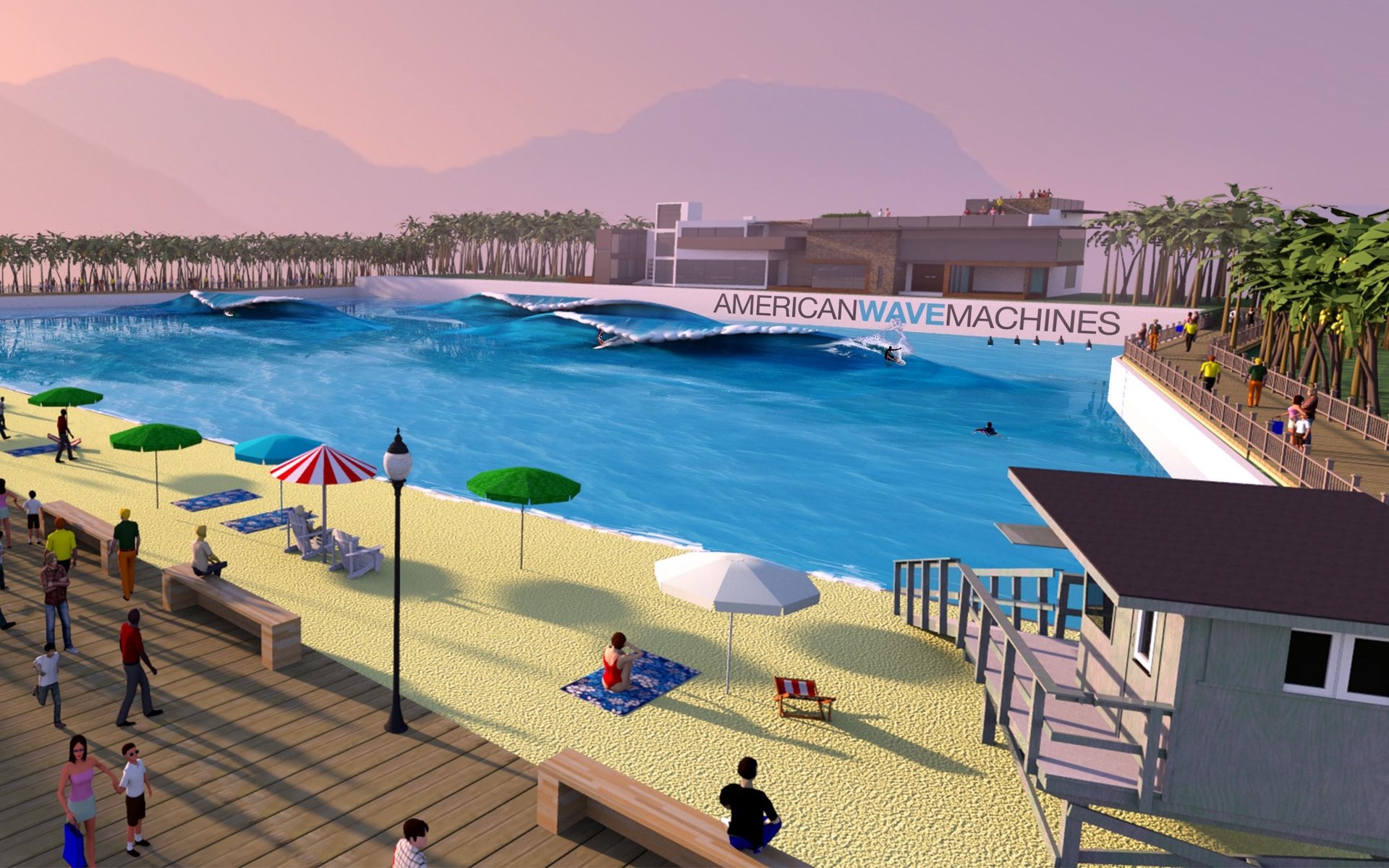
Making the economics of surf parks work is another matter. With multi-million dollar construction costs and high energy demand—the bigger the wave, the more power needed—there’s one make-or-break metric for any artificial wave technology: waves per minute. More waves means more surfers and more revenue.
The Murphy’s Waves machinery used at the Abu Dhabi surf park, for instance, generates only one wave every 90 seconds, a frequency considered too low to be financially viable. (The surf park, however, is part of a larger complex financed by the ruling family of the United Arab Emirates.) But Murphy told Quartz that his the next generation of his technology will create a wave every six seconds.
McFarland says PerfectSwell can also generate a wave every six seconds, meaning between 120 and 2,160 people an hour can surf repeatedly, depending on the size of the wave pool. A 150-foot by 90-foot (46-meter by 27 -meter) pool would consume as much as 298 kilowatts of electricity (costing $35 an hour in the US or $104 in Germany, according to rates compiled by International Energy Agency) while a 300-foot by 360-foot pool would suck up as much as 1,860 kilowatts ($223 in the US; $651 in Germany). Construction costs range from $3 million to $5 million for a smaller surf park and $5 million to $7 million for a large one.
Wavegarden says it can produce what it calls an “expert wave” every 30 seconds along with smaller waves for less experienced surfers. That translates into between 500 and 1,000 surfers an hour. The wave generator consumes 270 kilowatts of electricity, and construction costs start around €3 million ($4.1 million).
How much will it cost to surf an endless summer? Developers of a UK surf park that will use Wavegarden’s technology plan to charge an $8 entrance fee and $24 for an hour’s wave time.
Kelly Slater wants you to surf his wave
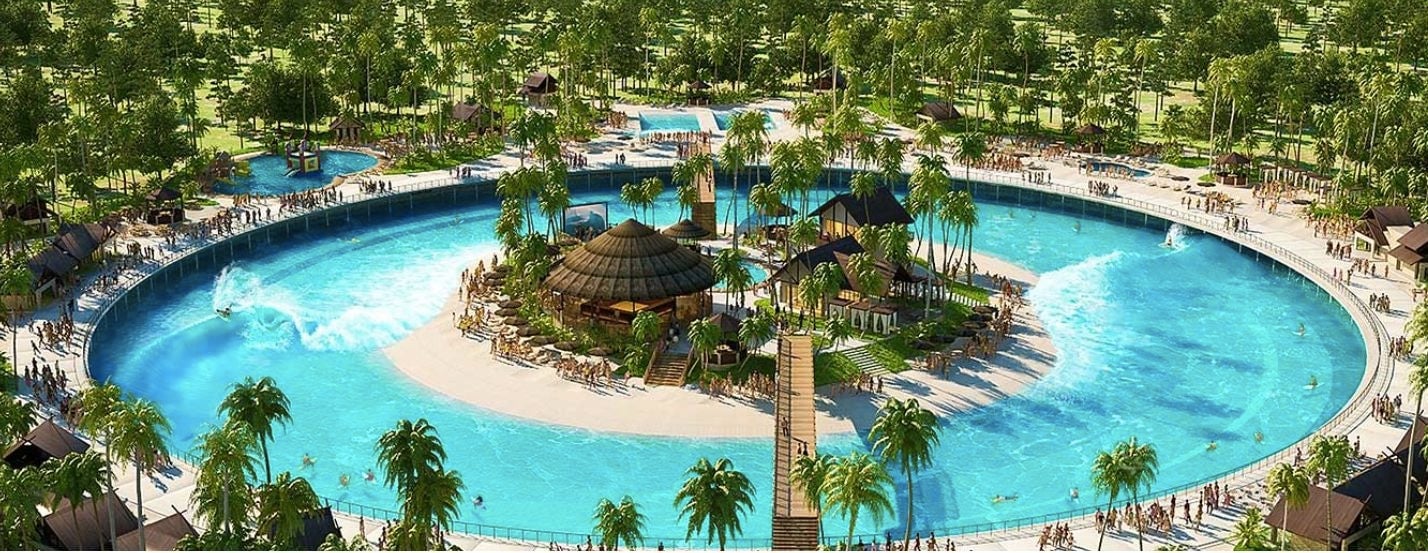
“To recreate a natural phenomenon in a contained area and to be able to control the elements of it, I think this is the future of surfing out of the ocean,” Kelly Slater says in promotional video for the company he started to develop his own artificial wave technology. “There is no surf culture to speak of in the middle of America but maybe in the future there could be because of something like this.”
The most influential surfer of his generation—and perhaps ever—the 41-year-old icon’s potential to popularize surf parks has attracted intense interest in the Kelly Slater Wave Company (KSWC). So far, though, the company has said little about its technology, other than to offer computer renderings of a huge circular wave pool where surfers would ride an endless wave generated by a hydrofoil. “Proprietary hydrofoil generators create specific types of swells that form directly next to the generator,” the company states on its website. “This allows for the direct creation of customized swells with high energy transfer rates. KSWC does not pump air or water to generate waves, as these processes are inefficient and unreliable.”
Noah Grimmett, the company’s chief operating officer, told Quartz that the KSWC is not commenting publicly about its plans. But Ponting of the Center for Surf Research has seen a scale-model demonstration of the technology at the company’s Los Angeles warehouse. “It’s just generating a 6-inch wave at the moment but it’s super impressive,” he says. “The wave can be turned up and down to make an absolute barrel. It looks perfect and entirely feasible.” McFarland has also examined the Slater tech. “It’s got potential,” he says of his competitor’s work.
Turning pro surfing into an arena sport
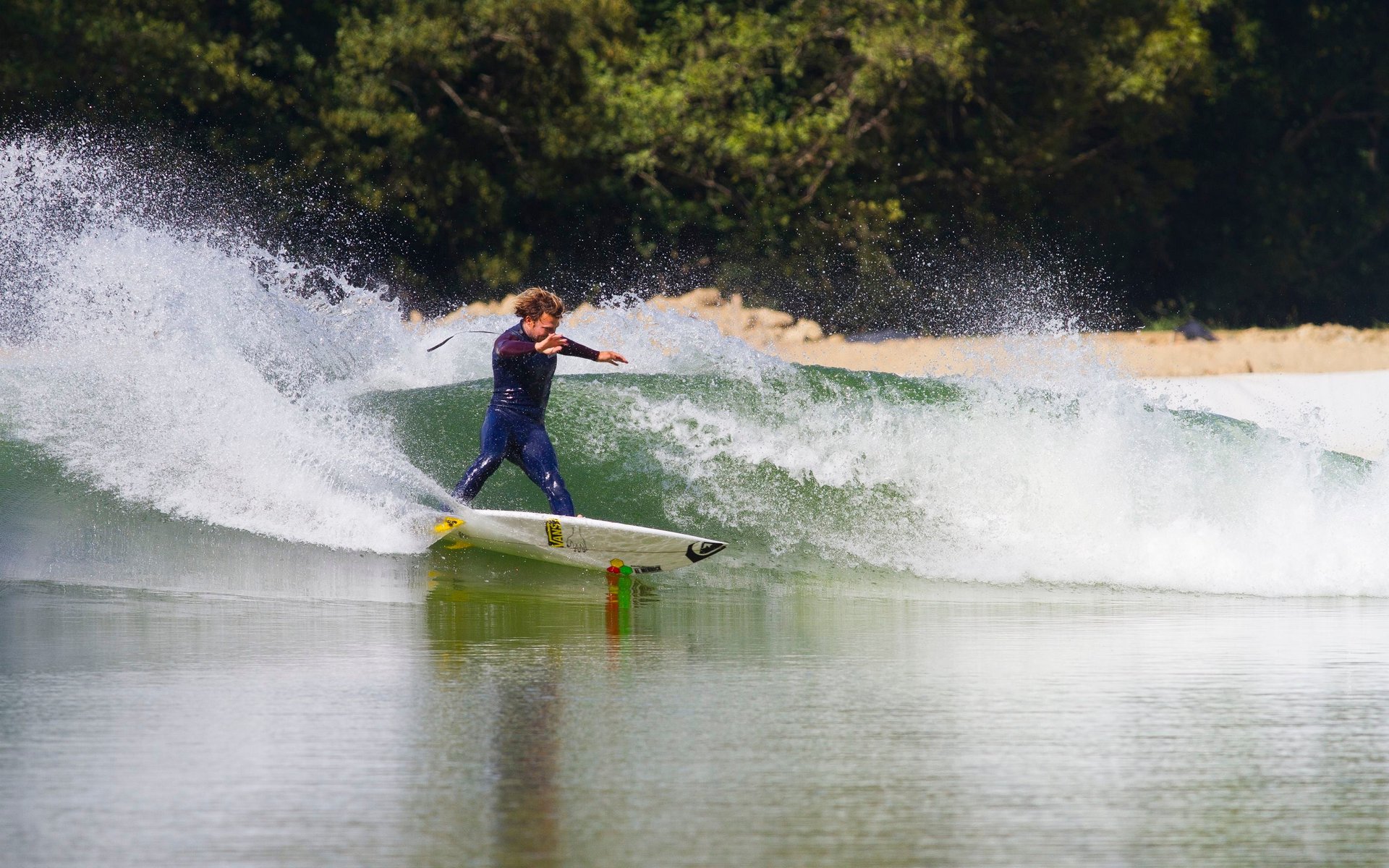
That’s of keen interest to pro surfing. The manager of Slater’s surfing career, Terry Hardy, serves as a director of KSWC. Last year, Hardy and Paul Speaker, a former NFL commissioner, took over the Association of Surfing Professionals (ASP), the organization that runs the global pro surfing circuit. The goal: Make professional surfing a mainstream sport that can be broadcast as fan-friendly contests—like a two-hour football game. Surf parks could be the ticket: Dial up uniform waves on command and minimize the subjectivity that inevitably comes when judging ocean surf contests, where no two waves are the same.
The president of the International Surfing Association, Fernando Aguerre, believes surf parks are a prerequisite for including surfing in the Olympics. “By standardizing the waves for surfing competition, the luck factor of getting a certain wave in the ocean will cease to become a sometimes important factor in determining the winner or loser of a surfing competition,” he said in statement. Pro surfers have already taken an interest in surf parks as a training tool, with stars like Dane Reynolds traveling to Spain to rip on Wavegarden’s artificial surf.
Are surf parks sustainable?
Not all surfers are stoked about surf parks; some are already raising objections to their potential carbon footprint. “It’s not cool to use carbon-based fuels to generate waves and cause climate change impacts,” Chris Hines of the UK group Surfers Against Sewage said in September at a surf park conference. Chad Nelson, environmental director of the Surfrider Foundation, says the carbon accounting is more complicated, given that surfers also leave a huge carbon footprint by flying around the world to hit the best breaks. Riding the waves at a local surf park may be more environmentally responsible than jetting to Indonesia, he notes.
Avoiding a wipeout
The biggest threat to the future of surf parks, however, may be hyped-up expectations. In 2008, it became apparent that artificial waves were not ready for prime time after the much-publicized Ron Jon Surf Park shut down before it could open in Florida, when its technology failed. That set back the industry for years. Insiders like Murphy of Murphy’s Waves see the potential for another wipeout amid the current surf park craze. “I think it’s mostly hype,” says Murphy, who’s been building wave machines since the 1980s. “I think there is a market out there but it probably needs to driven by wealthy business groups that see wave technology’s commercial potential rather than by young guys who surf and want a surf park.”